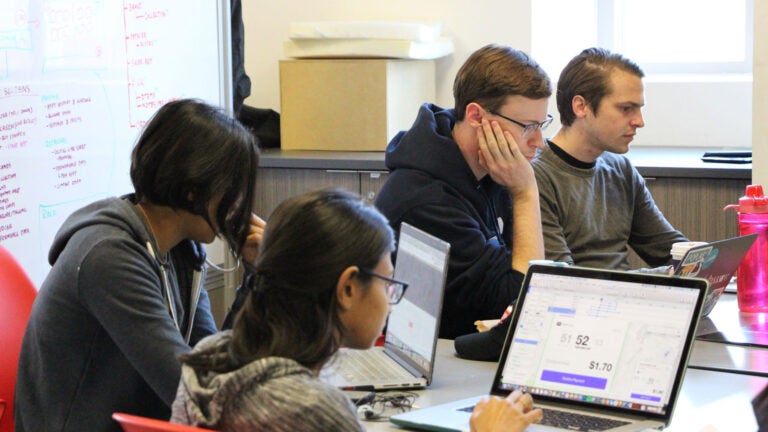
Ben Stanfield, second from right, worked with classmates to counter online radicalization and recruitment. They used a startup mentality: launch quickly and refine the product as you go. (USC Photo/Karine Kim)
‘Hacking for Defense’ students take on cybersecurity from a new angle
USC Iovine and Young Academy team ponders a tough question: How do you counter online radicalization?
With the rise of violent extremism at home and abroad, national security agencies typically focus on identifying and dealing with existing dangers. But in the “Hacking for Defense” class, students at the USC Jimmy Iovine and Andre Young Academy approach national security from another angle: What can we do to counter online radicalization in the first place?
This problem, set by sponsors from the national security and intelligence community, drove the student team’s semester-long project. Agencies like the Department of Defense are hardly new to counter-radicalization, but “Hacking for Defense” offers a new approach: teaching students to apply lean startup methodology to national security institutions that are not startups.
Fortunately, USC senior Ben Stanfield’s curriculum at the academy has trained him to find new angles and use unorthodox tools to solve problems.
Students constantly talk about which industries are the most ripe for change. This often leads to conversations about the evolving music industry, wearables, virtual reality and so on.
Ben Stanfield
“Students constantly talk about which industries are the most ripe for change. This often leads to conversations about the evolving music industry, wearables, virtual reality and so on,” Stanfield said. “We rarely hear about the Air Force or the CIA in these conversations about tech disruption. ‘Hacking for Defense’ presents students with a real, wicked problem faced by the Air Force, State Department, CIA and more, and provides you with the resources and mentorship to define a problem and create a solution.”
Not only do “Hacking for Defense” students define a problem and create a solution for these institutions, but they do so in highly responsive ways. Where traditional development would design a product or service and invest in perfecting it for launch, “Hacking for Defense” students take on the startup philosophy that perfect is the enemy of the good.
Instead, students create a minimum viable product and launch it as quickly as possible, gauging responses and iterating accordingly. Just as a scientist develops a hypothesis, tests it and refines the hypothesis based on the results, a lean startup constantly refines its products and services based on how they have been tested in the marketplace. Today, lean methodology predominates in the startup world, and the model is a core approach taught at the Iovine and Young Academy where Stanfield is pursuing his Bachelor of Science in Art, Technology and the Business of Innovation.
‘Hacking for Defense’ involves FBI agents and community leaders
Stanfield and his group began by interviewing 70 people — from FBI agents to community leaders — to understand the nature of the problem and analyze what kind of tools they could build to effectively address it. Stanfield recalled one memorable interview with an FBI agent where, for security purposes, the students didn’t even receive the address of the building until a few minutes beforehand. Despite the secrecy, the team found the special agent to be very receptive, though at one point he had to organize an early-morning house raid.
After hearing from experts and stakeholders, the team focused on creating digital tools to counter online radicalization and recruitment. They had weekly calls with the State Department to communicate progress and solicit feedback, allowing for the responsive development cycle that characterizes lean methodology.
The class ended with a final presentation as students presented their project to military and government personnel, including former CIA Director David Petraeus, who commended the group’s work. As Stanfield recounted: “After the presentation concluded, Gen. Petraeus jumped up next to us and addressed us directly, commending our presentation and our work on this particular problem, one which he spent a lot of time on himself during his tenure at the CIA.”
The ‘Hacking for Defense’ origin story
Though “lean manufacturing” dates back to the era of Henry Ford as a concept, it was Eric Ries, a student of Steve Blank, who adapted those ideas to the needs of startup firms. Blank, in turn, extended his student’s ideas by developing the “Hacking for Defense” course.
Blank created the course as part of the Lean LaunchPad program at Stanford University. In 2011, the Lean LaunchPad program partnered with the National Science Foundation’s Innovation Corps, which trains scientists and engineers in transferring their lab projects to the commercial marketplace using lean methodology. The program expanded to include other government agencies, including the National Institute of Health, the Department of Energy and the Department of Defense. Its curriculum is used at 11 other universities outside USC.



